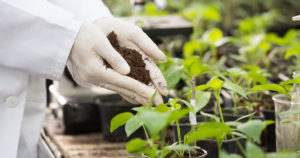
In research conducted at the University of Idaho, Huma Gro® X-Tend® B, powered by Micro Carbon Technology® (MCT), has proven to improve barley yield. The boost in production led to a higher net gain per acre with a return on investment (ROI) of 38:1. [Read more…]
BHN Acquires Warehouse in Tempe
By Lyndon Smith,
President and CEO
Bio Huma Netics, Inc.
 I’m excited to share that Bio Huma Netics, Inc. (BHN) has acquired an additional building in Arizona. It’s a significant milestone for us that not only testifies to the continual progress we’re making as a company but will also serve as a building block for future expansions. [Read more…]
I’m excited to share that Bio Huma Netics, Inc. (BHN) has acquired an additional building in Arizona. It’s a significant milestone for us that not only testifies to the continual progress we’re making as a company but will also serve as a building block for future expansions. [Read more…]
Research Report: Biostimulant Effect of Humic Acids on Tomato Plants Under Nutritional Stress
 In a research study, originally published in Frontiers in Plant Science, May 2021, Vol. 12:660224, the biostimulant properties of humic acids (HA) were tested on Micro Tom tomato plants under increasing nutritional stress. The results confirmed the positive role humic acids play in enhancing nutrient efficiency uptake in plants.
In a research study, originally published in Frontiers in Plant Science, May 2021, Vol. 12:660224, the biostimulant properties of humic acids (HA) were tested on Micro Tom tomato plants under increasing nutritional stress. The results confirmed the positive role humic acids play in enhancing nutrient efficiency uptake in plants.
A team of scientists from the Bio Huma Netics, Inc. (Hiarhi Monda, Ryan Fountain, and Rich Lamar) collaborated with Amy M. McKenna of the National High Magnetic Field Laboratory, Ion Cyclotron Resonance Facility, to conduct this research. The researchers believe that the increasing demands for biostimulants in the agricultural market requires the industry to provide research-based data on the efficiency and safety of this particular product category. This was the motivation that led them to initiate this extensive research. [Read more…]
Field Trial: Promax® and Zap® Reduce Nematodes, Increase Yields for Green Chiles

A recent field trial on green chile peppers has concluded that Promax® and Zap® treatment is noticeably effective in lowering the parasitic nematode population while improving the beneficial microbe population. This positive effect on the soil biology boosted the yield of green chile peppers and resulted in an increased profit for the farmer.
The Water Break Podcast Hits 5,000 Downloads

Our Water Break podcast has made a splash by reaching the milestone of 5,000 downloads this week. The steady growth of this project feels like a pat on the back and helps us stay motivated to come up with new content for our listeners each month.
According to the statistics report from Blubrry, our podcast hosting service, we have completed 5,014 downloads so far! It’s interesting to know that during the last 30 days we noted a 34% increase in downloads. Since we are now averaging close to 300 downloads per month, many would agree that these numbers look great for a podcast that caters to a very specific audience.
Why Are Humic Substances Called Acids?
By Richard Lamar, PhD
Senior Director of Humic Research
Bio Huma Netics, Inc.
 We are accustomed to seeing humic substances (humic and fulvic) in dry/granular form, and we tend to think of acids as liquids. So why are humic and fulvic substances called acids?All substances, solid AND liquid, have a chemical makeup. An acid is a chemical that can donate a proton (H+) to a water molecule (H2O, which would form H3O+) or to another chemical such as ammonia (NH3, which would form NH4+).
We are accustomed to seeing humic substances (humic and fulvic) in dry/granular form, and we tend to think of acids as liquids. So why are humic and fulvic substances called acids?All substances, solid AND liquid, have a chemical makeup. An acid is a chemical that can donate a proton (H+) to a water molecule (H2O, which would form H3O+) or to another chemical such as ammonia (NH3, which would form NH4+).
BHN Sponsors Online Course on Sustainable Organic Agriculture Production
 To help increase awareness about sustainable agriculture production, Bio Huma Netics, Inc., (BHN) is sponsoring a FarmProgress course for Certified Crop Advisers (CCAs) and Pest Control Advisers (PCAs) in the United States and Canada.
To help increase awareness about sustainable agriculture production, Bio Huma Netics, Inc., (BHN) is sponsoring a FarmProgress course for Certified Crop Advisers (CCAs) and Pest Control Advisers (PCAs) in the United States and Canada.
This free online continuing education course, titled “Organic/Sustainable Agriculture Production -2022” aims to help working professionals learn about sustainable farming practices and pest management without the use of synthetic chemicals.
During the training, participants will learn about most common pests in organic/sustainable agricultural systems and current methods of controlling insect pests, weeds, and diseases in a range of organic crops grown in the United States.
The two-hour duration course is divided into ten sections and allows participants to complete it at their own pace.
 In the last week of August, Probiotic Solutions® hosted a Wastewater Microbiology Course at our headquarters in Gilbert, Arizona. This educational event with Dr. Toni Glymph-Martin, cosponsored by
In the last week of August, Probiotic Solutions® hosted a Wastewater Microbiology Course at our headquarters in Gilbert, Arizona. This educational event with Dr. Toni Glymph-Martin, cosponsored by  The 2-day in-person course will cover various key topics related to wastewater microbiology including, but not limited to, microscopy, filamentous bacteria, etc. Attendees will also get a chance to participate in various hands-on learning activities for a better understanding. To know more about the course,
The 2-day in-person course will cover various key topics related to wastewater microbiology including, but not limited to, microscopy, filamentous bacteria, etc. Attendees will also get a chance to participate in various hands-on learning activities for a better understanding. To know more about the course,